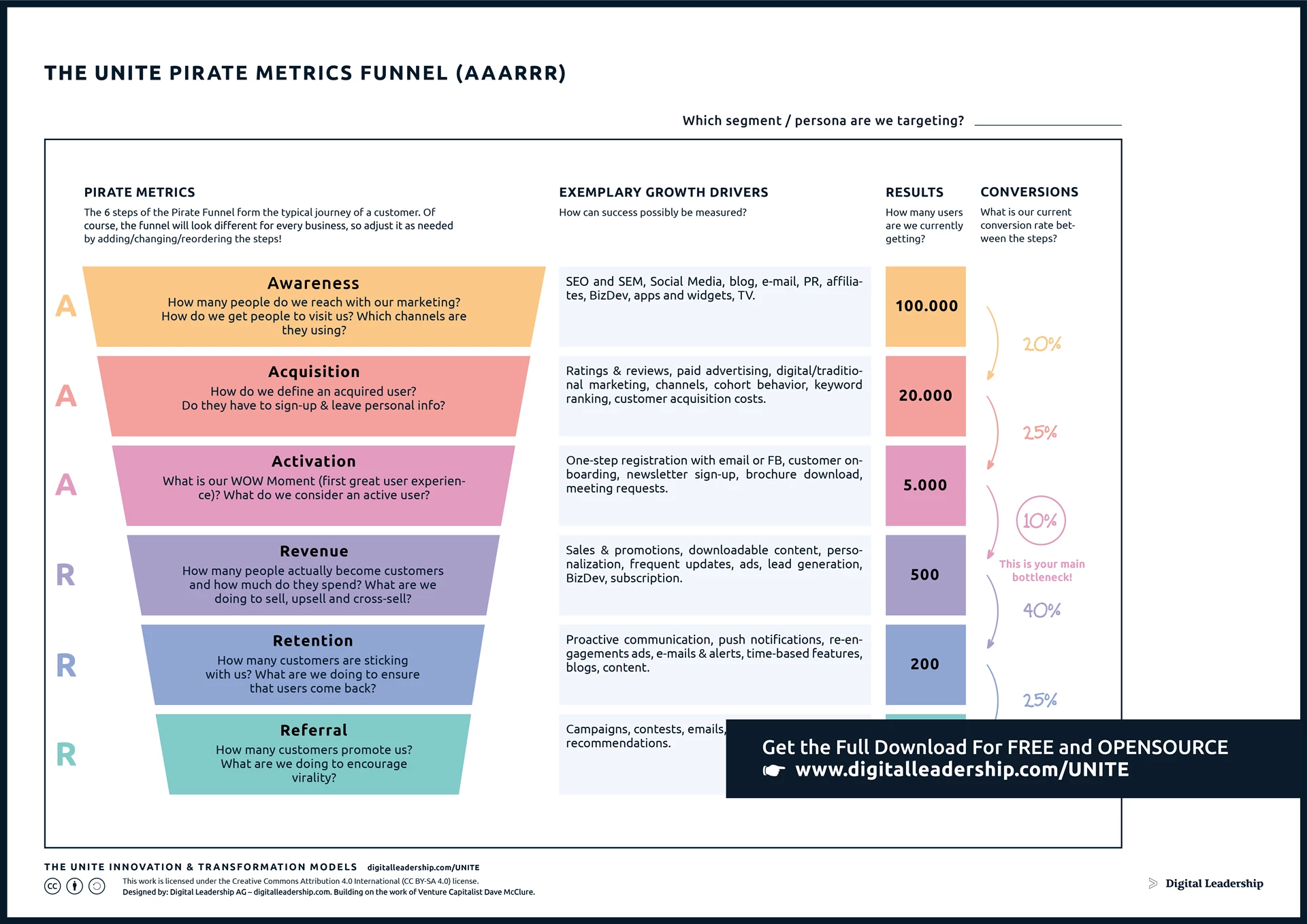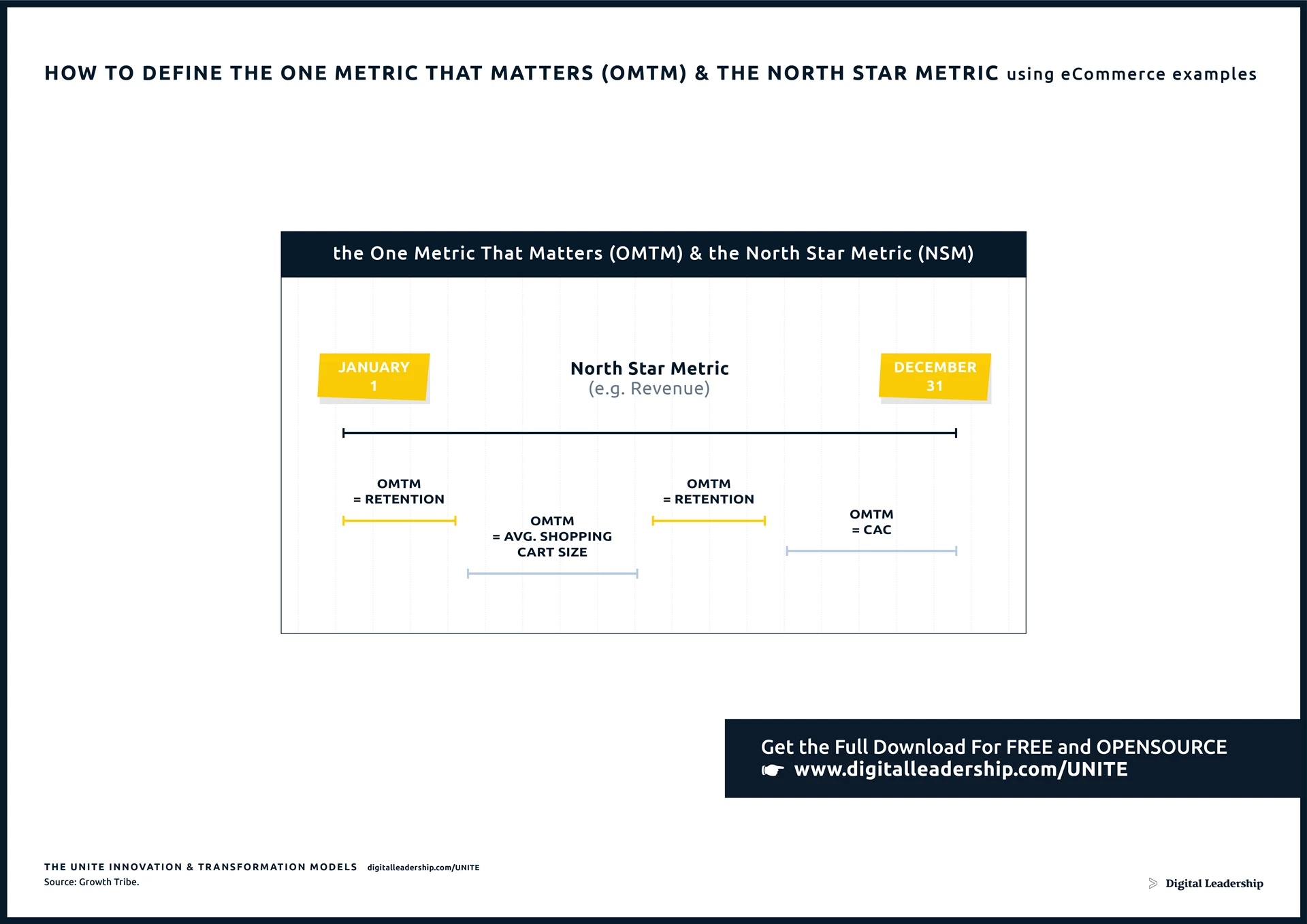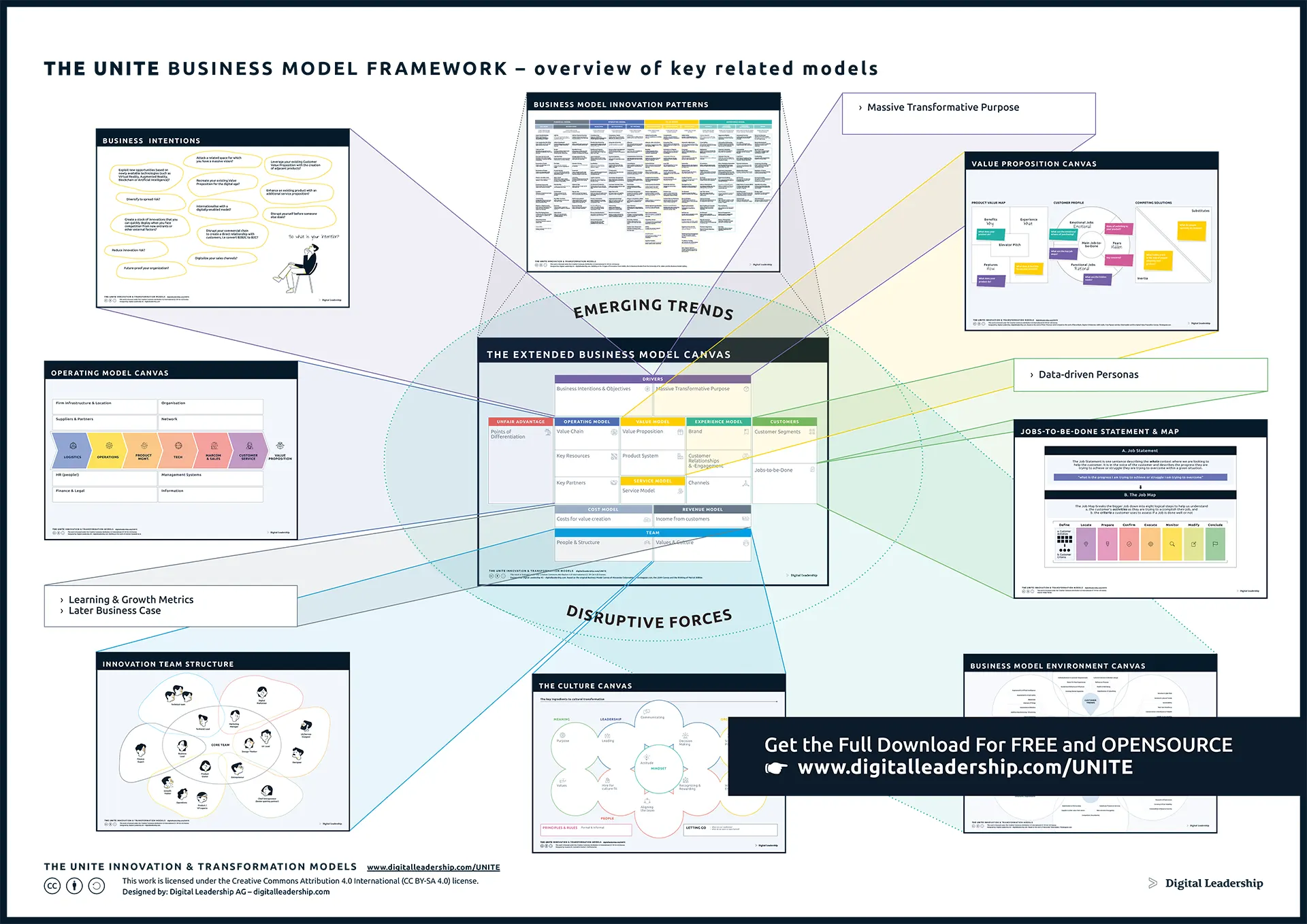Table of Contents
One of the basic practices of growth hacking is the Pirate Metrics Framework, also called the AAARRR Framework. (Say it out loud: “Aaarrr!” like a pirate.) For most growth hackers, this framework is an essential model used to find and move beyond their bottleneck.
In practice, the Pirate Metrics Framework divides the company and its practices into manageable pieces so it’s easier to direct time, resources, and attention to each. Most companies are complex entities, almost like living organisms, and unless we identify and focus on smaller pieces, the enormity of the entire enterprise can obscure the real problems.
Pirate Metrics aims to make close inspection easier so opportunities for growth and innovation can be developed and leveraged. We’ll begin this article discussing the elements of business that the Pirate Metrics Framework asks us to consider.
AAARRR Metrics – What does AAARRR Stand For?
Keep in mind that the steps of the funnel can be in a different order depending on the type of business you are in. So, use the Pirate Metrics Funnel as a canvas and define your own funnel with the metrics that are appropriate for your business.
The Pirate Metrics Framework helps us understand customer lifecycle stages so we can monitor user engagement with our product. With the framework, we identify user behavior to help guide investment in product marketing.
Metric (1): Awareness
Awareness metrics are key to brand awareness and how your marketing efforts introduce your company to potential customers.
How many people do we reach with our marketing?
How do we get people to visit us? Which channels are they using?
Awareness metrics can help product marketers understand how to best reach potential customers.
Metric (2): Acquisition
In acquisition metrics, you identify customers as individual users.
How do we define an acquired user? Do they have to sign-up & leave personal info? What investments are we making into the acquisition stage?
Acquisition metrics improve your understanding of who your customers are so you can use that information to generate new business.
Metric (3): Activation
Activation metrics identify when a customer actually tries your product. The average SAAS company understands activation metrics through strategies like limited time trials or freemium offers.
What is our WOW Moment (first great user experience)? What do we consider an active user? How do we recognize that new customers have entered the activation stage?
Activation metrics enable you to understand which customer experiences are the most impactful.
Metric (4): Revenue
Your revenue metrics track potential customers become paying customers.
How many people actually become customers and how much do they spend? What are we doing to sell, upsell and cross-sell? How do we convert more customers to the revenue stage? How do we recognize the beginnings of monetization behavior?
Revenue metrics help a company stay profitable and viable over the long term.
Related: Revenue Streams in Business Model Canvas
Metric (5): Retention
The measurement of ongoing revenue generated by a customer is the retention metric. When you consider the investment made in turning someone into a paying customer, any additional revenue from those existing customers can be considered “free.”
How many customers are sticking with us? What are we doing to ensure that users come back? What is our retention rate? How are we collecting and acting upon retention numbers?
Retention metrics allow a company service existing customers most effectively.
Metric (6): Referral
Referral metrics track how word-of-mouth marketing efforts and social impressions are adding to your customer base. Turning current customers into new customers through a referral process is an effective and efficient use of marketing resources.
How many customers promote us? What are we doing to encourage virality? Which channels produce the best results?
Why to use the AAARRR Pirate Metrics Framework?
The biggest reason to use AAARRR Pirate Metrics Framework is to push the way you analyze your business. Analytics can drive growth, but only if you’re taking the right measurements.

Designed by: Digital Leadership AG – Building on the Work of Venture Capitalist Dave McClure
Your download is now available!
You can now access the complete Pirate Metric Funnel (AAARRR) Package, including a full presentation, related models and instructions for use.
The AARRR Framework makes it possible to parse out the different areas of a business’s activities. For those of us toward the top of a company’s leadership pyramid, it may be difficult to completely grasp the day-to-day activities of every department across the entire organization. Pirate Metrics encourage us to look into those places we don’t often probe.
Pirate Metrics and Your Growth Hacking Process
The Operating Model you’ve created using your canvas should clarify how to execute your strategy and thus set up operations. Now we need to consider the best way to grow your innovation initiative. We suggest leveraging the Growth-Hacking framework, a commonly used to set of tactics and shortcuts that high-growth companies have used to achieve massive growth in short time frames.
Related Topics:
- Operating Model Canvas: Bridging the Strategy-Execution Gap
- The UNITE Strategy Execution Framework – A Guide to Successful Strategy Execution
Be aware, however, that Growth Hacking is not a simple process of scaling more of the same. Rather, it is a process of rapid experimentation across both marketing and product development to identify the most efficient ways to grow a business. At this point, you won’t be surprised that Stage 4 involves building, measuring and learning as well! Your MVP was set up in a simple way because it was a temporary experiment. Most of what we were doing was manual. As we Growth Hack, we need to find ways to build your real business as effectively and efficiently as possible
The primary focus of growth hacking is two-fold: lowering Customer Acquisition Costs (CAC) and creating long-term customer loyalty (thus increasing the long-term value of a customer—a concept known as Customer Lifetime Value, or CLV). The goal of growth hacking is long-term sustainable growth, not just short-term gain. Creating a sustainable cycle is key. Imagine your business is a bucket and your potential customers are water. You don’t want to pour water into a leaky bucket; it’s a waste of money. That is why a strong Growth-Hacking approach focuses not just on customer acquisition, but on retention.
Step (1): Achieving Solution/Market Fit
We move through actuating the product or service and testing it in real life by building what is called a Minimum Viable Product (MVP). In this stage, we achieve true quantitative customer validation.
Step (2): Understand your Segments
Next, you need a clear understanding of who your customer segments and thus who your Personas are (customer Personas are detailed representations of segments within your target audience).
Segmentation and Personas are NOT the best way to understand a market; Jobs to be Done is. However, understanding who is buying your product is critical for marketing: you need to specifically target the Personas or segments that match your JTBD assessment because this is the audience that is likely to convert. Get to know them.
Customer Personas are detailed representations of segments within your target audience. Fueled by data-driven research, they map the “who” behind the buying decisions of customers. Insights from customer Personas can help improve copy, tailor targeting, and inform product development. Great Personas, however, do not just appear. You have to start with research and importantly base your Personas on real data.
Related Topics:
- Jobs to be Done Framework, Theory, Examples, and Statements JTBD
- What is Customer Segments in you Business Model Canvas?
Step (3): The Pirate Funnel AAARRR
The most important tool for implementing the growth process is the Pirate Metrics Funnel created by venture capitalist Dave McClure. It is a phenomenal KPI-based framework that can be used for any business. The funnel enables you to understand what metrics and channels to focus on and to identify your potential bottlenecks in customer acquisition and retention. The process is organized into six different steps and represents the journey of your customers.
Step (4): The Metrics that Matter
With the help of your Business Intention and vision, you have identified the long-term goal that you want to achieve. But when you are in the midst of things, trying to get your business to scale, the Business Intention and the vision are often too abstract and remote to provide clear guidance. You will therefore need more operational metrics to guide you. We suggest two: one mid-term metric, the “North Star” and one short-term metric, the “One Metric That Matters” (OMTM). Focusing on just these two metrics will help you achieve your goals by reducing the clutter.
Related: Identifying your Business Purpose | Why are you even here?
North Star Metric – NSM
The North Star Metric (NSM) gives you mid-term guidance. It represents the overarching direction you are moving towards in the medium term. All decisions and metrics along the way should bring you closer to this North Star. You could go as far as breaking down your journey into a number of consecutive North Star Metrics that will slowly pave the way towards achieving your vision.
The One Metric that Matters – OMTM
The One Metric That Matters (OMTM) is the metric you are trying to optimize in your current sprint or release. It helps you focus your experiments and iterations.
To bring the two together, imagine you are on the path toward your North Star, perhaps a certain monthly revenue target, but suddenly an obstacle stands in your way. Using the Pirate Funnel, you’ve identified customer retention as a bottleneck. You make this your One Metric That Matters until you have reached that more specific target.

Designed by: Digital Leadership AG – Source: Growth Tribe
Your download is now available!
You can now access the complete Growth Hacking Package, including a full presentation, related models and instructions for use.
The UNITE Business Model Framework: A Framework for Innovation Success
How to Create Innovation includes a number of canvases that focus on value creation and finding the right business model to meet your customer segment and customer needs. The framework is built to inspire drastic changes that help you find a competitive advantage. Our hope is that your company grows through business model innovation, and so we again encourage you to look deeper into our website and the book.
Here is a summary of the key ingredients of the Business Model Framework:

Designed By: Digital Leadership AG
Download the complete Business Model Framework package, including instructions for putting it to work for you today.
Business Models
The centerpiece is the Business Model Canvas, which covers the six main areas of a Business Model (the Operating, Value, Service, Experience, Cost, and Revenue Models).
The eXtended Business Model Canvas adds the immediate business context, including Business Drivers, customers, and the team, as well as the Unfair Advantage.
Detailed Models
A Business Model can be broken out into its numerous aspects. Depending on what challenges you face, you can zoom in on your area of interest using an appropriate tool or canvas:
- Your Business Intention and objectives as well as your Massive Transformative Purpose summarize your drivers and give direction to what you do.
- The Value Proposition Canvas details the central components of your offering (the product or service).
- To dig into your Customer Segments, work with data-driven Personas.
- The JTBD Customer Job Statement and Job Map frame the JTBD of your customers.
- The Business Model Environment puts your Business Model in a market context composed of emerging trends and disruptive forces.
- The Innovation Culture Canvas helps you understand and consciously shape a culture that supports innovation.
- The Innovation team structure enables you to draft a team structure for your innovation initiative.
- Using learning and growth metrics, you can measure progress at the initial stages of development. These metrics help you focus on what really matters instead of creating a detailed business plan that will not really help you. Later on, you can expand the financial aspect of the Revenue and Cost Models with a full business case.
- The Operating Model Canvas helps you think through the Operating Model.
- Business Capability Map: A Practical Business Approach
Closing Thoughts
AARRR Metrics give you a framework for the important elements of growth and innovation. They allow you to more closely reflect upon each piece of your business.
AARRR Pirate Metrics are just the beginning, though. It’s the work that comes next that turns hope and planning into a paying customer.





























 Book How to Create Innovation
Book How to Create Innovation